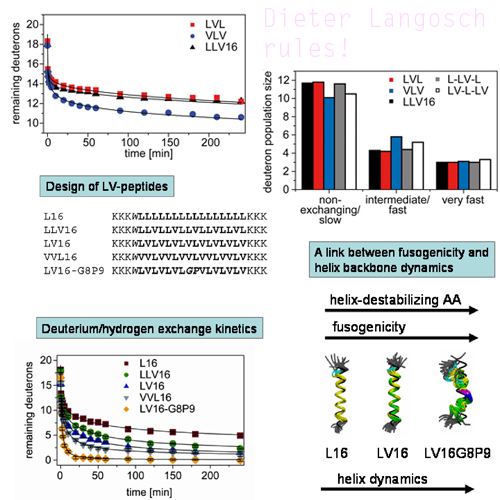Sequence-specific conformational dynamics of model transmembrane domains determines their membrane fusogenic function
14-Apr-2009
Journal of Molecular Biology, 2009, 386, 733-41 published on 14.04.2009
Journal of Molecular Biology, online article
Journal of Molecular Biology, online article
The transmembrane domains of fusion proteins are known to be functionally important and display an overabundance of helix-destabilizing Ile and Val residues. In an effort to systematically study the relationship of fusogenicity and helix stability, we had previously designed LV-peptides, a low-complexity model system whose hydrophobic core consists of Leu and Val residues at different ratios. The ability of LV-peptides to fuse membranes increases with the content of helix-destabilizing residues. Here, we monitored the kinetics of amide deuterium/hydrogen-exchange of LV-peptide helices to probe their conformational dynamics. The kinetics indeed increase strongly with the content of helix-destabilizing residues and are likely to reflect local fluctuations of the helix backbones as all peptides exhibit uncorrelated exchange and contain sub-populations of amide deuteriums that exchange with different velocities. Interestingly, helices whose amide deuteriums are shifted from slower into faster sub-populations are more fusogenic. To map functionally relevant helix subdomains, novel peptide variants were designed, where Val residues are concentrated at peripheral or central domains of the hydrophobic core, respectively. Their structural and functional analysis suggests that dynamic domains close to the helix termini are more relevant for fusogenicity than central domains but cooperate with the latter to achieve strong fusogenicity. We expect that studies provide new vistas for investigating the impact of transmembrane domains on lipid membranes.











